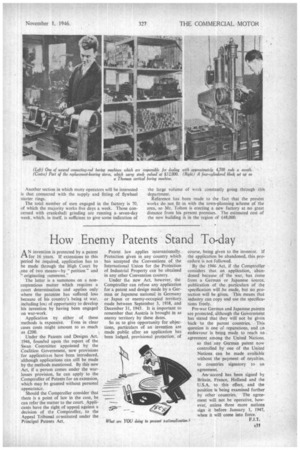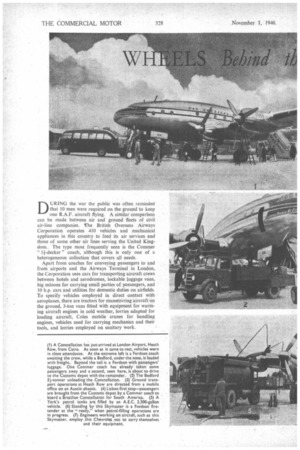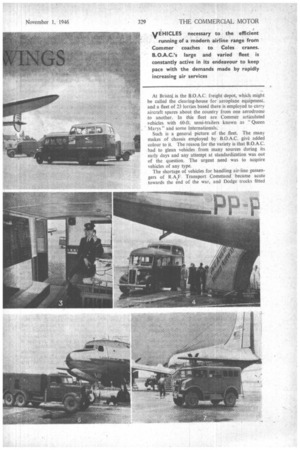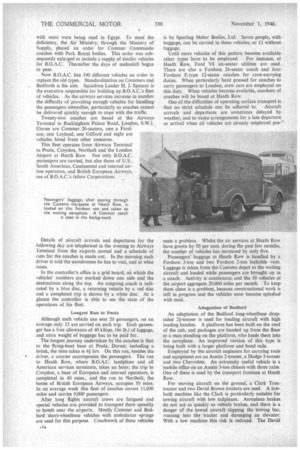How Enemy Patents Stand To-day
Page 33

Page 34

Page 35

Page 36

Page 37

If you've noticed an error in this article please click here to report it so we can fix it.
AN invention is protected by a patent for 16 years. If extensions to this period be required, application has to be made through the High Court by one of two means—by " petition " and " originating summons."
The latter is a summons on a noncontentious matter which requires a court determination and applies only where the patentee has suffered loss because of his country's being at war, including los.; of opportunity to develop his invention by having been engaged on war-work.
Application by either of these methods is expensive. Even in clear cases costs might amount to as much as £200.
Under the Patents and Designs Act, 1946, founded upon the report of the Swan Committee appointed by the Coalition Government, new provisions for applicatioos have been introduced, although applications can still he made by the methods mentioned. By this new Act, if a person comes under the warlosses provision, he can apply to the Comptroller of Patents for an extension, which may be granted without personal apnea ranee.
Should the Comptroller consider that there is a point of law in the case, he can refer the matter to the court. Applicants have the right of appeal against a decision of ti-e Comptroller, to the Appeal Tribunal censtituted under the Principal Patents Ad.
Patent law applies internationally. Protection given in any country which has accepted the Conventions of the International Union for the Protection of Industrial Property can be obtained in any other Convention country.
Under the new Act, however, the Comptroller can refuse any application for a patent and design made by a German or Japanese national in Germany or Japan or enemy-occupied territory made between September 3, 1938, and December 31, 1945. It is important to remember that Austria is brought in as enemy territory by these dates.
So as to give opportunity for objections, particulars of an invention are made public after an application has been lodged, provisional protection, of course, being given to the inventor. If the application be abandoned, this procedure is not followed.
By the 1946 Act, if the Comptroller considers that an application, abandoned because of the war, has Come from a German or Japanese source, publication of the particulars of the specification will be made, but no protection will be given. This means that industry can copy and use the specifications freely.
Pre-war German and Japanese patents are protected, although the Governthent has stated that they will not be given back to the parent countries. This question is one of reparations, and an endeavour is being made to reach an agreement among the United Nations, so that any German patent now controlled by one of the United Nations can be made available without the payment of royalties, to countries signatory to an agreement.
An accord has been signed by Britain, France, Holland and the U.S.A. to this effect, and the position is being examined further by other countries. The agreement will not be operative, however, unless three more nations sign it before January 1, 1947, when it will come into force.
DUR1NG the war the public was often reminded that 10 men were required on the ground to keep one R.A.F. aircraft flying. A similar comparison can be made between air and ground fleets of civil air-line companies. The British Overseas Airways Corporation operates 410 vehicles and mechanical appliances in this country to feed its air services and those of some other air lines serving the United Kingdom.. The type most frequently seen is the Commer " 1k-decker" coach, although this is only one of a heterogeneous collection that covers all needs.
Apart from coaches for conveying passengers to and from airports and the Airways Terminal in London, the Corporation uses cars for transporting aircraft crews between hotels and aerodromes, lockable luggage vans, big saloons for carrying small parties of passengers, and 10 h.p. cars and utilities for domestic duties on airfields. To specify vehicles employed in direct contact with aeroplanes, there are tractors for rnanceuvring aircraft on the ground, 3-ton vans fitted with equipment for warming aircraft engines in cold weather, lorries adapted for loading aircraft, Coles mobile cranes for handling engines, vehicles used for carrying mechanics and their tools, and lorries employed on sanitary work.
(1) A Constellation has lust arrived at London Airport, Heath Row, from Cairo. As soon as it came to rest, vehicles were in close attendance. At the extreme left is a Fordson coach awaiting the crew, while a Bedford, under the nose, is loaded with freight. Beyond the tail is a Fordson with passengers' luggage. One Commer coach has already taken some passengers away and a second, seen here, is about to drive to the Customs depot with the remainder. (2) The Bedford 21-tonner unloading the Constellation. (3) Ground transport operations at Heath Row are directed from a mobile office on an Austin chassis. (4) Lisbon first stop—passengers are brought from the Customs depot by a Commer coach to board a. Brazilian Constellation for South America. (5) A York's petrol tanks are filled by an A.E.C. 2,500-gallon vehicle. (6) Standing byhi Skymaster is a Fordson firesender at the "ready," when petrol-filling operations are in progress. (7)Engineers working on aircraft, such as this Skymaster, employ this Chevrolet van to carry themselves
At Bristol is the B.O.A.C. freight depot, which might be called the clearing-house for aeroplane equipment, and a fleet of 23 lorries based there is employed to carry aircraft spares about the country from one aerodrome to another. In this fleet are Commer articulated vehicles with 60-ft. semi-trailers known as "Queen Marys" and some Internationals.
Such is a general picture of the fleet. The many makes of chassis employed by B.O.A.C. give added colour to it. The reason for the variety is that B.O.A.C. had to glean vehicles from many sources during its early days and any attempt at standardization was out of the question. The urgent need was to acquire vehicles of any type.
The shortage of vehicles for handling air-line passengers of R.A.F. Transport Command became acute towards the end of the war, and Dodge trucks fitted with seats were being used in Egypt. To meet the deficiency, the Air Ministry, through the Ministry of Supply, placed an order for Comrner Commando coaches with Park Royal bodies. This order was subsequently enlarged to include a supply of similar vehicles for B.O.A.C. Thereafter the days of makeshift began to pass.
Now B.O.A.C. has 340 different vehicles on order to replace the old types. Standardization on Commers and Bedfords is the aim. Squadron Leader H. J. Spencer is the executive responsible for building up B.O.A.C.'s fleet of vehicles. As the airways services increase in number the difficulty of providing enough vehicles for handling the passengers intensifies, particularly as coaches cannot be delivered quickly enough to cope with the traffic.
Twenty-two coaches are based at the Airways Terminal in Buckingham Palace Road, London, S.W.1. Eleven are Commer 20-seaters, one a Ford: son, one Leyland, one Gifford and eight are vehicles hired from other concerns.
This fleet operates from Airways Terminal to Poole, Croydon, North°It and the London Airport at Heath Row. Not only B.O.A.C. passengers are carried, but also those of U.S., South American, Continental and internal airline operators, and British European Airways, one of B.O.A.C.'s fellow Corporations.
Details of aircraft arrivals and departures for the following day are telephoned in the evening to Airways Terminal from the airports named and a schedule of runs for the coaches is made out. In the morning each driver is told the aerodromes he has to visit, and at what times.
In the controller's office is a grid board,o which the vehicles' numbers are marked down one side and the destinations along the top. An outgoing coach is indicated by a blue disc, a returning vehicle by a red disc and a completed trip is shown by a white disc. At a glance the controller is able to see ffie state of the operations of his fleet.
Longest Run to Poole Although each vehicle Can seat 20 passengers, on an average only 15 are carried on each trip. Each passenger has a free allowance of 40 kilogs. (66 lb.) of luggage, and extra weight of baggage has to be paid for.
The longest journey undertaken by the coaches is that to the flying-boat base at Poole. Dorset; including a break, the time taken is 44 hrs. On this run, besides the driver, a courier accompanies the passengers. The run to Heath Row, where B.0,A.C. landplane and all American services terminate, takes an hour; the trip to Croydon, a base of European and internal operators, is completed. in 40 mins., and the run to Northolt, the home of British European Airways, occupies 50 nuns. In an average week this fleet of coaches covers 11,000 miles and carries 9,000 passengers. •
After long flights aircraft crews are fatigued and special vehicles are. provided to transport them speedily to hotels near the airports. Mostly Commer and Bedford 'short-wheelbase vehicleswith ambulance springs are used for this purpose. Coachwork of these vehicles is by Spurling Motor Bodies, Ltd. Seven people, with baggage, can be carried in these vehicles, or without luggage.
Until more vehicles of this pattern become available other types have to be employed. For instance, at Heath Row, Ford V8 Six-seater utilities are used. There are also a Fordson 26-seater coach and four Fordson E-type 12-seater coaches for crew-carrying duties. When particularly hard pressed for coaches to carry passengers to London, crew cars are employed on this duty. When vehicles become available, numbers of coaches will be based at Heath Row.
One of the difficulties of operating surface transport is that no strict schedule can be adhered to. Aircraft arrivals and departures are sometimes delayed by weather, and to make arrangements for a late departure or arrival when all vehicles are already employed pre sents a problem. Whilst the air services at Heath Row have grown by 50 per cent. during the past few months, the number of vehicles has increased by only five.
Passengers' baggage at Heath Row is handled by a Fordson 3-ton and two Fordson 2-ton lockable vans. Luggage is taken from the Customs depot to the waiting aircraft and loaded while passengers are brought .up in a coach. Activity is continuous, and the 30 vehicles at the airport aggregate 20,000 miles per month. To keep them clean is a problem, because constructional work is still in progress and the vehicles soon become splashed with mud.
Adagtation of Bedford
An adaptation of the Bedford long-wheelbase dropsided 24-tonner is used for loading aircraft with high loading hatches. A platform has been built on the roof of the cab, and packages are handed up from the floor to a man standing on the platform, who loads them into the aeroplane. An improved version of this type is being built with a larger platform and hand rails.
Employed by the aircraft engineers for carrying tools and equipment are an Austin 2-tonner, a Dodge 3-tanner and two Chevrolets. An extremely useful vehicle is a mobile office on an Austin 3-ton chassis with three axles. One of these is used by the transport foreman at Heath Row.
For moving aircraft on the ground, a Clark Truetractor and two David Brown tractors are used. A lowbuilt machine like the Clark is particularly suitable for towing aircraft with low tailplanes. Aeroplane brakes do not act as quickly as vehicle brakes, and there is a danger of the towed aircraft slipping the towing bar, running into the tractor and damaging an elevator. With a low machine this risk is reduced. The David Brown tractors have Turbo-transmission, which gently overcomes the inertia of a big aeroplane. Great satisfaction has been given by these machines, and further orders have been placed.
Petrol tankers and fire-engines at Heath Row are under the control of the Ministry of Civil Aviation. An A.E.C. tanker has a capacity of 2,500 gallons.
The various departments at Heath Row are at present some distance apart_ Contact between them is maintained' by some Hillman Minx cars, Humber saloons and Fordson utilities.
To alleviate congestion, all vehicles have to run on certain specified routes about the aerodrome. The aircraft apron is rather small and is usually crowded with aircraft. A speed limit of 15 m.p.h. is imposed on vehicles on the apron. Driving at night on the aerodrome, among many glaring floodlights, is tricky. The manner in which drivers handle their vehicles, especially the coaches, on the apron calls for quickness of eye and brake. When the London Airport is complete, the main buildings will be in the centre, and coaches running from there to the Bath Road will go through a tunnel.
Other airports garage their vehicles on the premises, but as there is no covered accommodation at Heath Row, vehicles spend the night at Heston aerodrome. In a hangar there, where Spitfires used to be assembled, is the maintenance depot for all 13 O.A.C. vehicles. Machines are also packed there for delivery to overseas aerodromes. Forty vehicles can be dealt with at the same time by the staff of 75.
There is little specialized maintenance equipment, although big orders for tools have been placed and should be delivered in a year. In the opinion of the maintenance engineer, one of his most useful items is the Clark lift truck.
Every 1,000 miles, each vehicle receives a running check-over at its home base, except those centred on Airways Terminal and Heath Row, which are done at Heston. After covering 15,000 miles, vehicles are docked at Heston; complete overhauls are made after 30,000 miles.
Improvisation has eased the difficulties of maintenance caused by the shortage of machine tools. At Heston an ex-R.A.F. workshop trailer, fitted with motor, compressor and drill, is used in the hangar.
Adjoining the main hangar is the paintshop building, where Airgraph spraying equipment is used. A new colour scheme is being introduced on B.O.A.C. vehicles, in which cream colour will extend to the waistline and cover the top of the bonnet.
Outside the Customs at Heath Row is this Commer 7-11-seater car to take the crew of a liner to an hotel. Also engaged on this duty is a Ford V8 on the left.
This type can seat six persons.
The smart appearance of all B.O.A.C. vehicles is commendable. Many foreign visitors, mostly of affluence, are handled by the Corporation, and national prestige is enhanced by courteous, efficient reception arrangements at the Airport, including a comfortable and speedy service of road transport It is no exaggeration to say that much of B.O.A.C. s efficiency depends upon those handling its surface transport. A.S.




































































